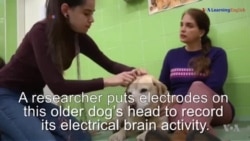There is an English proverb that says, "Let Sleeping Dogs Lie." It means to not bring up an old problem.
Researchers in Hungary have found another reason to let dogs keep on sleeping. It seems the animals are learning while they sleep.
The scientists placed wires on the dogs' heads to measure electrical activity in the brain. The brain activity, called sleep spindles, takes place in human beings, and has been linked with learning.
The Hungarian scientists hope to understand how the dogs' ability to learn and remember changes as they get older. The study may help researchers understand how human brains change as we age.
Ivaylo Iotchey is a neuroscience researcher. He says that this is the first time dogs’ sleep spindles have been measured, and related to the dogs learning new things.
"From studies with humans and rodents, we know that they are extremely useful markers both of memory and cognition but also of aging and activity. In the dog, sleep spindles have only been described, they were never quantified, they were never related to function. This is the first time we were able to show that sleep spindles predict learning in the dog.”
Gender differences in learning
The scientists found differences between male and female dogs. Iotchey says the females appeared much better at learning new things.
“Female dogs have approximately, on average, twice as many spindles per minute as male dogs, and they also happen to be the better learners, they memorize the task much better."
But it was harder for all the older dogs to remember things, especially when several things were happening at the same time.
Old dogs and new tricks
Dóra Szabó also studies sleep spindles.
Szabo is a neuroscientist with Eötvös Loránd University in Budapest. She says the older dogs were easily tricked.
“If you first hide the reward into one pot, then in another and in another, they get confused after a while. So their performance is declining, and they are getting less effective in solving novel problems and shifting from one task to another."
Researchers hope the study will not only help understanding of cognitive ability and memory changes in dogs, but also the aging process in humans.
Senior Researcher Enikó Kubinyi adds that the aging dogs suffer from the same problems as humans who are aging.
"Among very old dogs, up to two thirds of them show signs of dementia, and this dementia is really very similar in a lot of aspects to that of humans, so we could use dogs as a natural model of human aging."
The team collects tissue from dogs’ brains and shares diseased tissue samples with researchers around the world.
I’m Jill Robbins.
Deborah Block reported this story for VOANews.com. Dr. Jill Robbins adapted her report for Learning English. George Grow was the editor.
________________________________________________________________
Words in This Story
proverb – n. a popular saying
sleep spindles – n. a burst of brain activity that signals the beginning of deeper sleep
quantify – v. to find or calculate the quantity or amount of (something)
confused – adj. unable to understand or think clearly
decline – v. to become worse in condition or quality
novel – n. new and different from what has been known before
senior – adj. of or related to a higher rating or education
What do you think of this research? Do you watch your dog sleep? Do you think he or she is learning while sleeping? We want to hear from you. Write to us in the Comments Section.








